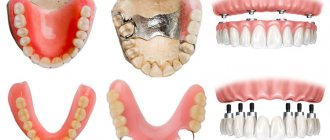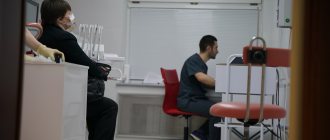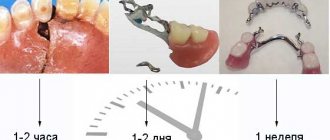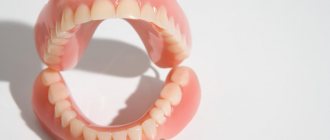An open smile puts you at ease, adds confidence and increases self-esteem. But poor environment, poor nutrition, oral diseases and hereditary factors can cause tooth decay or loss. Some people are intimidated by the idea of having false teeth and don't know how to wear or care for them. What to do if you encounter this problem? Specialists from the INTAN Implantation and Dentistry Centers will help restore your smile to its natural appearance by installing good removable dentures that do not affect your quality of life.
After examining the oral cavity, the dentist will decide which dentures are suitable for the patient, taking into account his age, condition of the teeth and individual characteristics. Removable dental prosthetics is carried out in the case of complete or partial absence of teeth and involves the installation of a structure that must be periodically independently removed from the mouth for hygienic cleaning. Modern dentures look very aesthetically pleasing, practically no different in appearance from your own teeth, and allow you to smile, talk and eat any food without embarrassment.
Oral examination
Any treatment process must begin with an examination. A preliminary examination allows you to determine the need for prosthetics, choose the optimal type of design and amount of work.
Examination of the oral cavity in dentistry Additional examination (instrumental, x-ray, etc.) provides information about the condition of the supporting teeth, periodontal tissue, bone tissue, the need for root canal treatment, and the possible presence of inflammatory elements at the tops of the root canals or in the bone.
This is an integral stage of successful prosthetics, as it allows not only to identify and eliminate hidden problems, but also to avoid possible complications in the future, after installation of the prosthesis .
Possible breakdowns and repairs
The main cause of failure is improper storage of the prosthesis, a fall from a height. If the structure is deformed when worn incorrectly, displacement of the units occurs, and the artificial enamel breaks off when bitten. Less common problems:
- violation of prosthetic technology;
- low quality materials;
- aging of plastic;
- frequent inflammation of the gums.
Trying to glue a bridge or butterfly yourself will only worsen the condition of the plastic or nylon. Many dental clinics provide free denture repairs to pensioners and preferential categories of patients.
Preliminary treatment
Dental treatment is an important point not only before prosthetics or implantation, but throughout life. Timely sanitation of the oral cavity preserves the health and integrity of the dental system, avoids possible complications, as well as the spread of infection throughout the body. Treatment of abutment teeth , hidden and obvious carious cavities, acute inflammatory processes in periodontal tissues or bones is mandatory before starting any prosthetics. This will allow not only to eliminate defects or diseases that have arisen in a timely manner, but also to extend the service life of the prosthesis. Also, some fixed structures require mandatory endodontic treatment.
Price of products
The cost of prosthetics depends on the chosen base material and teeth, the amount of work of the technician:
- acrylic full - from 10,000 rubles;
- nylon full from 25,000 rubles;
- clasp - from 20,000 rubles;
- “butterfly” – from 3000 rubles.
In each case, the cost is calculated individually and includes preliminary treatment. In public clinics, the cost of making prostheses for pensioners may include good discounts.
Stages of dental prosthetics
Rarely does dental prosthetics happen in a single stage; generally, it is a sequential, multi-stage process. After preliminary endodontic treatment, it is necessary to restore the supporting teeth using inlays or pins. Then the doctor prepares (grinds) them to create a place for the prosthetic structure, takes impressions from both jaws and the prosthetic area, and determines the color of the artificial teeth. A very important step in prosthetics is determining the occlusion (the relationship of the jaws), which allows you not to interfere with the prosthesis during chewing.
The impressions are sent to the dental laboratory. This is a kind of information for a dental technician about the shape and size of the teeth, the anatomical features of the prosthetic bed, the location and type of structure. Based on the impressions obtained, the dental technician casts diagnostic and working models from plaster, which are an exact copy of the teeth, and in the case of complete edentia, the gums. Next, the structure itself is modeled with wax and the prosthesis itself is created using various methods and techniques. Sometimes during its manufacture it requires checking, fitting and fitting. The finished structure is fixed in the oral cavity. In some cases, additional correction of the prosthesis is required during the adaptation period.
Materials for the manufacture of removable dentures
The main requirements for the materials from which removable dentures are made are non-toxicity and the ability to look natural. A number of materials are used for these purposes, including:
- acrylic;
- plastic;
- zirconium;
- nylon;
- pressed ceramics;
- silicone;
- polyurethane;
- metal ceramics;
- clasp.
Based on what kind of material is used to create removable dentures, they receive certain properties. For example, the advantages of products made from metal ceramics and acrylic are strength and attractive appearance, while the advantage of products made from polyurethane and nylon is their flexibility. As for the shape and color of removable dentures, in all cases they are determined individually. Modern technologies provide the opportunity to create products with high aesthetic properties. Each of the listed materials has its own advantages and disadvantages. Therefore, when choosing, it is necessary to take into account the characteristics of each material and its suitability to your own needs. In solving this problem, recommendations from dentists can be of significant help.
Category Dentures Posted by admin
Stages of dental prosthetics with metal-ceramics
process of metal-ceramic dentures begins with the preparation of previously prepared abutment teeth and obtaining a two-layer impression.
Bridges They are removed with special elastic masses, which allows the dental technician to accurately convey information about the shape, size and location of the teeth and the orthopedic structure.
Next, temporary crowns or bridges are fixed onto the prepared teeth in order to temporarily restore the cosmetic defect and prevent changes and displacement of the tissues of the prosthetic bed. Central occlusion is determined - the nature of the closure of the teeth of both jaws. All received data is transferred to the dental laboratory. At the next visit, the solid metal frame of the prosthesis is fitted and the color of the ceramic veneer is determined and sent back to the laboratory for ceramic veneering. On the third visit, the doctor fits and temporarily fixes the finished metal-ceramic prosthesis . Sometimes at this visit the prosthesis is fixed with permanent cement. Temporary fixation allows, if necessary, to adjust the prosthesis during the adaptation period.
Manufacturing time for removable dentures
The speed of manufacturing dentures depends on several factors, the main ones being the materials and technologies used. If you answer approximately the question of how long it takes to make a removable denture , then you can focus on the following time frames.
- Clasp dentures on telescopic crowns are made in approximately three to four weeks;
- Clasp dentures with attachments are manufactured in approximately twenty days;
- Clasp dentures with hooks are made in about ten to twelve days;
- Plate dentures are made in approximately thirteen to sixteen days;
- Soft plastic dentures are made in about five to ten days;
- Nylon dentures take approximately seven to ten days to complete.
Stages of dental prosthetics with inlays
Ceramic inlays are a type of microprosthetics, which is a modern alternative to conventional fillings. They fill previously prepared cavities in the teeth, restoring their shape and function. The indication for ceramic inlays is the ability to save a tooth with significant destruction of its coronal part (up to 65%).
At the initial stage of tooth preparation, the doctor removes all tissue destroyed by the carious process and, if necessary, carries out endodontic treatment. After the tooth is cured, an impression is taken and sent to the laboratory, where a ceramic inlay is made . At the next visit, the finished structure is fixed to the tooth using special cement. Ceramic inlays have high strength and durability, and are color resistant to food coloring. They are also highly aesthetic.
Technique for making removable dentures
Poor chewing of food due to missing teeth can impair the functioning of the gastrointestinal tract. In some cases, the only way to restore chewing function, which is extremely important for maintaining health, and to regain a beautiful smile, is to make removable dentures. technology protects the jaws from further destruction. The manufacture of removable dentures is carried out in cases where natural teeth for some reason could not be preserved. Removable prosthetic structures are attached to the jaw due to the ability to stick to it. They have the shape of curved plates on which artificial teeth are installed. The shape and color of the teeth are selected according to the individual needs and wishes of the patient. The color of a removable denture is as close to natural as possible. How are removable dentures made today? The technology of making dentures has now reached a level that far exceeds that of the recent past. Modern production of dentures is based on the use of new technologies and materials. Thanks to the successes that dentistry has achieved to date , removable dentures have high strength characteristics, aesthetic properties and hygienic qualities. Removable prosthetic structures have no age restrictions, and their manufacture takes into account the individual characteristics of the patient’s jaws, thereby minimizing discomfort when using them. Of course, dentures should not cause discomfort in the mouth. For this reason, dentists advise not to remove them for the first time after installation, so you can monitor the human body’s reaction to them and make adjustments if necessary.
Stages of dental prosthetics with complete edentia
The production of a complete removable denture begins with an examination of the patient’s oral cavity, diagnosis of the condition of the dental system, and selection of a suitable design. The first impression is taken with a standard impression tray. Depending on which design is chosen, the impression mass is selected. The impressions are sent to the laboratory, where a dental technician casts plaster models and makes a wax base with occlusal ridges and custom impression trays.
On the second visit, using these trays, the doctor takes functional impressions, and using rollers, determines and fixes the occlusion. All information is transmitted to the dental technician. He makes the future prosthesis from wax with acrylic (plastic) teeth .
On the third visit, the structure in the oral cavity is checked, occlusion, fit, and the appearance of the patient’s face are assessed. The doctor makes the necessary notes and corrections and transfers the future design to the laboratory. The dental technician finally models the wax structure, plaster it into a cuvette where the wax is replaced with plastic. Next, he grinds and polishes the finished prosthesis.
At the next visit, the prosthesis is handed over. Finished structures are fitted, fit, occlusion and aesthetics are checked. The doctor will tell the patient how to use and care for the new prosthesis. During the adaptation period, additional corrections are possible.
Structure care
In order for the prosthesis to retain its shape and appearance for a long time, it is necessary to carefully care for it every day:
- Clean thoroughly twice a day with a high-quality paste without abrasives;
- purchase special brushes for nylon structures;
- exclude nuts, crackers, and hard meat from the diet;
- store removable dentures as recommended by your dentist;
- use irrigators to remove food debris.
Do not use boiling water to kill bacteria: high temperatures will deform the plastic base.
Stages of prosthetics with veneers
Veneers are thin ceramic plates that are fixed to the front surface of previously prepared teeth and allow them to correct cosmetic defects, change shape, size and color.
Crowns and veneers The first stage, as with any prosthetics, is a survey, examination and
diagnosis of the oral cavity .
If necessary, X-ray and laboratory tests are performed. A very important stage is planning future structures, taking into account not only the condition of the teeth and oral cavity, but also the gender, age, and character of the patient. The shape of the face, the gingival margin and smile line, and the individual characteristics of the teeth are assessed. The size of the veneers is predicted and calculated. A photographic record is being taken. The doctor models the future restoration on a computer using a special program and demonstrates the result to the patient. At the next visit, the teeth are prepared, starting with cleaning their surfaces from plaque. The required shade of filling material is selected. Under anesthesia, the front surface of the teeth is prepared and the required amount of enamel is removed. The next step is taking impressions. Based on the dental impressions obtained, a plaster model is cast in the laboratory to obtain an exact copy of the patient’s teeth, on which the dental technician makes future veneers. After the doctor has prepared the teeth, temporary veneers . A dental technician, using computer systems, special scanners, sensors and ovens, produces structures strictly according to the specified parameters.
At the next visit, the doctor tries on the finished structures. If necessary, adjustments are made, deficiencies are eliminated, and the bite is checked. Veneers are fixed to the teeth using special cement.
Evaluation of results
Among the subjective evaluation criteria after prosthetics, it is important for the dentist to know:
- whether there is discomfort;
- is there pain when bitten;
- time to get used to it.
If the patient is missing only a few teeth, partial restorations can be used. Fixation is carried out on adjacent units using clasps - small metal locks. The stages of making prostheses are simpler, but also require precision and accuracy.
Read Zirconium dental crowns - indications for installation, prices and reviews
The second stage of assessment is carried out 3–4 weeks after the end of prosthetics:
- quality of manufacturing of metal-plastic prostheses;
- natural enamel shade;
- how much the ability to chew has been restored;
- density of closure of molars and incisors.
When defects are identified, dentures are corrected and repaired to remove the defects.
Dangers of toothless life
Which of us is unfamiliar with the expression “eats so much that it’s cracking behind the ears”? But a person with partial or complete loss of teeth can hardly boast of “crackling sounds behind the ears” while eating. He has to exclude hard food from his diet, or swallow it after barely chewing it. And as you know, food, when crushed, begins to be digested in the mouth, but with large pieces the stomach will have to cope with triple strength. The already mentioned “crackling behind the ears” is due to the fact that the salivary glands are located in the parotid region. It is they who produce the production of a very important hormone that is involved in the regulation of calcium metabolism; in addition, it affects the blood coagulation and anticoagulation systems, the metabolic processes of the liver, stomach and other vital organs. With partial or complete absence of teeth, chewing movements of the lower jaw are limited, which invariably leads to dysfunction of the salivary glands. This is where changes in the composition of the blood and sudden gastric and liver dysfunctions appear. And a violation of calcium metabolism in the body, among other things, will undoubtedly have a negative “echo” on the remaining teeth. In addition, a person who is missing one or more teeth suffers from the inability to smile broadly, laugh, or conduct a normal conversation, which can negatively affect his communication with others and lead to stress. If this happens, the conclusion is clear - dental prosthetics is simply necessary for a person to continue a normal life.










